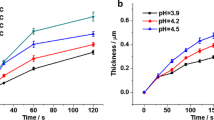Abstract
Multilayer thick-film technology is one of the important technologies adopted in the miniaturization of electronic systems. Generally, only interconnections are made in the intermediate layers. The possibility of fabricating resistors along with interconnections in the buried layers/intermediate layers using conventional thick-film materials has been examined in this study. The fabrication has been carried out by processing layer after layer. It has been found that the buried layer resistors exhibited a sheet resistivity lower than those fabricated as open resistors. This change in sheet resistivity has been attributed to multiple firings that the resistors undergo during the fabrication. This reduction in sheet resistivity has been found to be due to segregation of active materials. A model has been proposed to explain this change in sheet resistivity through segregation of the active material. The work reported in the paper clearly indicates that buried resistors with consistent values (±10%) can be fabricated using conventional materials. However, the design of the resistors has to be carried out using modified sheet resistivities. The model that is proposed also indicates how one can make a paste that is likely to exhibit the same sheet resistivity for buried resistors and open resistors.
Similar content being viewed by others
References
H. Lamb in “Hydrodynamics” (Cambridge University Press, London, 1989) p. 599.
D. S. Mathur, in “Mechanics” (Vikas Publishing, New Delhi, India, 1978) p. 770.
O. Abe, Y. Taketa and M. Haradome, Active Passive Electron. Compon. 13 (1988) 7.
T. Badri Narayana, K. Ramkumar and M. Satyam, IEEE Trans. Compon. Hybrids, Manuf. Technol. (1991) 894.
N. P. Bansal, R. H. Doremus, in “Handbook of Glass Properties” (Academic Press Inc., New York, 1986) pp. 97, 299.
F. Singer and S. S. Singer, in “Industrial Ceramics” (Chapman & Hall, New York, 1963).
G. S. Brady and H. R. Clauser, in “Materials Handbook” (McGraw-Hill Book Co., New York, 1986) p. 692.
R. W. Vest, B. S. Lee and S. Vasudevan, “Proceedings of International Conference on Electronic Components and Materials” (Academic Publishers, Beijing, 1989) p. 100.
K. W. Allison and J. D. Provance, Electronic Packaging and Production (May 1979).
M. Hrovat, D. Belavic, Z. Samardzija and J. Holc, J. Mater. Sci. Lett. 20 (2001).
M. Hrovat, D. Belavic, Z. Samardzija and J. Holc, ibid. 10 (2000).
M. Jakubowaska and K. Pitt, J. Mater. Sci. Mater. Electron. 6 (1995).
P. Yang, P. Rodriguez, P. Kotula, B. K. Meira and D. Dimos, J. Appl. Phys. 89 (2001).
P. Rodriguez, P. Kotula, B. K. Meira and D. Dimos, J. Electroceram 5 (2000).
Author information
Authors and Affiliations
Rights and permissions
About this article
Cite this article
Yadagiri, G., Goswami, K.K., Gurumurthy, K.S. et al. Studies on buried layer resistors. Journal of Materials Science: Materials in Electronics 13, 615–620 (2002). https://doi.org/10.1023/A:1020112501154
Issue Date:
DOI: https://doi.org/10.1023/A:1020112501154




